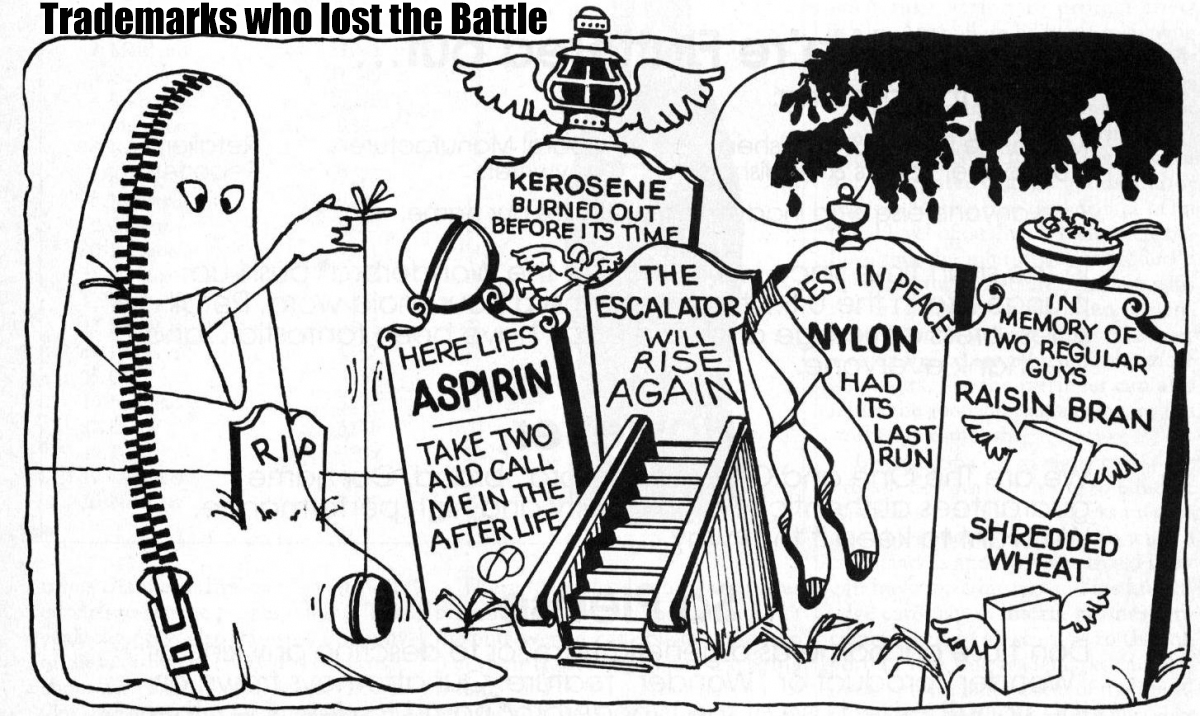Proper use of Trademarks and the ACID Test
A Trademark is “any word / combination of words used or intended to be used, in commerce to identify and distinguish the goods of one manufacturer / seller from goods manufactured or sold by others and to indicate the source of goods†(Cornell, 2004). Fundamentally, it is represented with a mark which determines its strength and legal grounds in the market. Having said that the trademark should be used very carefully as it is always under the threat of genericide. Trademark genericide refers to a situation where a mark becomes synonymous with the general product or service causing the mark to become generic or common to trade, which usually happens against the owner’s intentions. This typically happens when the trademark has acquired a substantial amount of market dominance and such that the primary meaning of the generalized trademark becomes the product service itself, rather than being an indication of the source. One of the classic examples of a firm losing its trademark name would be the case of Bayer’s Aspirin trademark; wherein this case it is most commonly used as Aspirin which is its generic term. Aspirin was recognized as the common name without emphasis on Bayer’s, which wasn’t its trademark. This made space for other companies to use Aspirin as the name of their product as the name Aspirin wasn’t registered. (Quirk, 2014, Tulett, 2014, International Trademark Association, 2015).Other examples include cases such as Prem Singh vs. Cec Industries where the Board had observed that the first party showed traces of imitated trademark and copyright of a third party, and in this case, the Courts can decline evidence. Allowing it would be damage in the reputation of the party and dishonesty, which is prohibited. Â
Consequences of such an event can be colossal for any business and in some rare cases it can even lead to the closure of business especially when the genericized mark is the sole trademark of the business.
A trademark offers innumerable benefits to a firm but with it comes the responsibility of properly using a trademark and making sure the use is in compliance with lex loci. When it’s a question of proper use, a test such as the ACID test can be put into place where the owner / individual themselves can check and prevent any possible genericization for the future. This paper will discover the proper use of Trademarks, how trademarks can become generic and talk about protection from Generic Terms.
ACID Test
The ACID Test has proved its reliability by being recognized by the court in the case of Bayer’s Aspirin Trademark case. ACID in this case, represents:
- Adjectives;
- Consistence;
- Identification of Status; and
- Distinctiveness
In order to ensure the proper use of trademarks, one should make sure that the trademark is an Adjective; for example “I drank four STARBUCKS lattes†or “I usually wear LEVI’S jeansâ€.
Next, is ensuring that there is a Consistent reference to the mark with the same representation each time, so it can be easy for the audience / consumer to assume and imply what the mark is.
Thirdly, there is the Identification of Status of the mark. Being, whether the make is registered, unregistered or has a service mark. This needs to be very clear and consistent for the consumer.
Lastly, the Distinctiveness of the mark. It should be clearly represented with consistency either in bold letters, capital letters, italics; based on the owners choice. There are various brands that represent the placement of the ACID test, for example: “Canon® Cameras†and “Callaway golf clubsâ€; the symbol and italicized text represent that the court has agreed upon the company’s use of it to represent the brand. Canon, for instance, used the appropriate symbol as a strong ground to avoid genericization, Callaway golf clubs used distinctiveness of the italics to stand out. Below, are mentioned ways to avoid genericization.
Avoiding Genericization
Genericization can occur amongst the general or the subpopulation. Usually, it occurs as nothing else comes to mind, or because the users may not realize that the term is a brand name rather than a generic term. Although Xerox Corporation prevented XEROX from becoming synonymous with “photocopy†the mark still reports to be generic in lots of countries. LEGO mark conducted a campaign which persuaded customers to call the products “LEGO blocks†or “LEGO toysâ€; this kept the mark alive and well (WIPO, 2009). In order to avoid genericization, there are several things that can be done. First off, like the aforementioned ACID test, there should be:
Consistency
- A consistency of a name/style of representation of the product to avoid any confusion which can create genericization names. It is essential that the trademark stands out. There can / should be use of Capital Letters, Bold Letters, Italics, to make your trademark eye-catching and clear. It could also be possible to make the trademark a product description, in order to make it simple for the audience to use – again, standing out in its own way; with consistency. It is very important that the same symbol/description is used everywhere to make the mark more recognizable and consistent. For example:
- It is essential for the trademark to stand out, in the sense that, there is use of
- capital letters,
- bold letters, etc. to make it evident that the word stands out.
- It could be possible to make the trademark a product description, in order to make it simple for the audience to use.
- Such as, “I want to purchase KELLOGG’S cornflakes†(FRKelly, 2009).
Appropriate symbols/Educating businesses/consumers
- There should be an appropriate symbol placed where necessary. This is to show the appropriate establishment of the mark, so the audience including consumers and competitors are aware. Educating businesses and consumers on the proper use would be useful as it can prevent any imitation and help point out imitation if necessary.
Consider a Brand name for the Mark
For example, Band’Aid’s had an advertisement saying “I’m stuck with band-Aid, ‘cause Band-Aid’s stuck on me†convincing the audience and putting such words in their mouth would provide them with a short, catchy word – preventing possible genericization.
Consider having a generic term    Â
- Most importantly, the owner of the trademark could consider developing a generic term as their trademark so they can prevent any issues regarding it, that might arise in the future.  For example, the Xerox case. “Xerox†has become synonymous for “photocopy†and the company Xerox doesn’t condone to the use of its trademark (Tulett, 2014). The company is highly concerned about the ongoing use of the word “Xerox†in countries like India and Russia where it is used on a daily basis (Sivaraman, 2012). This daily use places the trademark in danger as being declared as a generic term and so Xerox has started campaigning and advertising to condemn the use of it. Nonetheless, after all these efforts, the Intellectual Property Appellate Board of India (IPAB) declared “Xerox†as a non-generic term, but as of 2015, it is still very commonly used as a synonym for photocopy (Sivaraman, 2012). Public education campaigning was very effective for Xerox, a similar case to LEGO, that they managed to convince the consumers to refrain them from using XEROX in a synonymous context of photocopying. Xerox, representing the machine in which photocopying can be done.
- An example for such as case is the case of Uttam Chemical Udyog vs. Shris Rishi Lal Gupta. A registered trademark which was “5-Bhaiâ€, where the numerical was to be disclaimed. The registrar concluded that the word “Bhai†had become publici juris and passed an order imposing respect for the word “Bhaiâ€. On appeal, the High Court provided exclusive rights to use the combination “5-Bhai†with regard to the goods, however, they couldn’t stop the use of the numerical or word “Bhai†independently, or with a combination that doesn’t relate to the goods.
Trademarks, need to be used properly and carefully or else they can become generic and loose their value as mentioned, in the descriptions above. In order to protect them from that, there are various ways in which one can protect them from becoming generic. With the close bond most companies have with their consumers today, it would be very wise for companies to choose a trademark, which reaches out to them. This could be something simple and catchy to prevent genericization and thus, create strong pressure on the competitors of the market.
Work Cited:
Overview of Trademark Law. (n.d.). Retrieved July 18, 2016, from https://cyber.law.harvard.edu/metaschool/fisher/domain/tm.htm
Anderson, E. (2000). PROTECTION OF TRADEMARKS FROM USE IN INTERNET ADVERTISING BANNER TRIGGERS: PLAYBOY V. NETSCAPE. Jurimetrics, 40(4), 469-484. Retrieved from https://www.jstor.org/stable/29762675
Quirk, M. B. (2014, July 19). 15 Product Trademarks That Have Become Victims Of Genericization. Retrieved July 18, 2016, from https://consumerist.com/2014/07/19/15-product-trademarks-that-have-become-victims-of-genericization/
Gunelius, S. (2014, March 12). When and How Do I Have to Use Trademark Symbols? Retrieved July 18, 2016, from https://www.forbes.com/sites/work-in-progress/2014/03/12/when-and-how-do-i-have-to-use-trademark-symbols/#62c2c0077c41
Copyright Information Center. (2004, November 11). Retrieved July 18, 2016, from https://copyright.cornell.edu/policies/trademarks-at-cornell.cfm
GUIDELINES TO PROPER TRADEMARK USE [PDF]. (2008, March 25). Usps.gov.
Fair Use of Trademarks (Intended for a non-legal audience). (2016). Retrieved July 18, 2016, from https://www.inta.org/TrademarkBasics/FactSheets/Pages/Fair-Use-of-TrademarksNL.aspx
Collins, B. (2014, May 28). ‘Genericide’: Brands destroyed by their own success. Retrieved July 18, 2016, from https://www.bbc.com/news/business-27026704
5 Rules to Avoid your Trade Mark Becoming Generic [PDF]. (2009). FRKelly.
Sivaraman, R. (2012, September 23). Appellate Board upholds trademark status of Xerox. Retrieved July 18, 2016, from https://www.thehindu.com/news/national/tamil-nadu/appellate-board-upholds-trademark-status-of-xerox/article3927133.ece
Trademarks vs. Generic Terms. (2015, June). Retrieved July 18, 2016, from https://www.inta.org/TrademarkBasics/FactSheets/Pages/TrademarksvsGenericTermsFactSheet.aspx
Taylor, C., & Walsh, M. (2002). Legal Strategies for Protecting Brands from Genericide: Recent Trends in Evidence Weighted in Court Cases. Journal of Policy & Marketing, 21(1), 160-167. Retrieved from https://www.jstor.org/stable/30000717
O’Brien, P. (1976). Trademarks in Developing Countries. The Journal of Modern African Studies, 14(2), 297-309. Retrieved from https://www.jstor.org/stable/160061
Singh, R. (n.d.). World Intellectual Property Organization. Retrieved July 21, 2016, from https://www.wipo.int/wipolex/en/text.jsp?file_id=128107
Previous Next Concept of trade mark under the Trade Marks Act 1999 and the protection of domain names under Indian law. (2001, July 12). Retrieved July 21, 2016, from https://www.iflr.com/Article/2027427/Concept-of-trade-mark-under-the-Trade-Marks-Act-1999-and-the-protection-of-domain-names-under-Indian.html
Sharma, H. (2014, March 14). India: Validity Of Part Of Trademarks. Retrieved July 21, 2016, from https://www.mondaq.com/article.asp?article_id=299648
Bayer Co. (n.d.). Retrieved July 21, 2016, from https://cyber.law.harvard.edu/metaschool/fisher/domain/tmcases/bayer.htm
World Intellectual Property Organization. (2009, November). Retrieved July 21, 2016, from https://www.wipo.int/wipo_magazine/en/2009/06/article_0010.html
Sunkar, M. K. (n.d.). Copyright Law in India. Retrieved July 28, 2016, from https://www.legalserviceindia.com/article/l195-Copyright-Law-in-India.html
By-
Hitanshi J. Shah,
Intern at Fusion Law School,
Studying at
KIS International School University: Utrecht University





